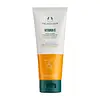What's inside
What's inside
 Key Ingredients
Key Ingredients

 Benefits
Benefits

 Concerns
Concerns

 Ingredients Side-by-side
Ingredients Side-by-side

Water
Skin ConditioningBambusa Arundinacea Stem Powder
AbrasiveCI 77220
Cosmetic ColorantGlycerin
HumectantStearic Acid
CleansingCetyl Esters
EmollientCetyl Alcohol
EmollientCaprylic/Capric Triglyceride
MaskingKaolin
AbrasivePotassium Stearate
CleansingGlyceryl Caprylate
EmollientCaffeine
Skin ConditioningSodium Hyaluronate
HumectantTourmaline
Bentonite
AbsorbentSucrose
HumectantHelianthus Annuus Seed Oil
EmollientHelianthus Annuus Seed Extract
Skin ConditioningPoria Cocos Sclerotium Extract
AstringentXanthan Gum
EmulsifyingTocopherol
AntioxidantAscorbyl Palmitate
AntioxidantMagnesium Aluminum Silicate
AbsorbentPEG-100 Stearate
Simethicone
EmollientEthylhexylglycerin
Skin ConditioningSodium Phytate
Phenoxyethanol
PreservativeCI 77891
Cosmetic ColorantWater, Bambusa Arundinacea Stem Powder, CI 77220, Glycerin, Stearic Acid, Cetyl Esters, Cetyl Alcohol, Caprylic/Capric Triglyceride, Kaolin, Potassium Stearate, Glyceryl Caprylate, Caffeine, Sodium Hyaluronate, Tourmaline, Bentonite, Sucrose, Helianthus Annuus Seed Oil, Helianthus Annuus Seed Extract, Poria Cocos Sclerotium Extract, Xanthan Gum, Tocopherol, Ascorbyl Palmitate, Magnesium Aluminum Silicate, PEG-100 Stearate, Simethicone, Ethylhexylglycerin, Sodium Phytate, Phenoxyethanol, CI 77891
Water
Skin ConditioningCoco-Glucoside
CleansingGlycerin
HumectantCocamidopropyl Betaine
CleansingPerlite
AbsorbentAcrylates/C10-30 Alkyl Acrylate Crosspolymer
Emulsion StabilisingPhenoxyethanol
PreservativeXanthan Gum
EmulsifyingCaprylyl Glycol
EmollientSodium Chloride
MaskingJojoba Esters
EmollientParfum
MaskingSodium Citrate
BufferingSodium Gluconate
Skin ConditioningLimonene
PerfumingSodium Hydroxide
Buffering3-O-Ethyl Ascorbic Acid
Skin ConditioningTrisodium Ethylenediamine Disuccinate
Benzyl Salicylate
PerfumingMyrciaria Dubia Fruit Extract
Skin ConditioningLinalool
PerfumingBenzyl Alcohol
PerfumingAloe Barbadensis Leaf Juice Powder
Skin ConditioningCitric Acid
BufferingTalc
AbrasiveCI 73360
Cosmetic ColorantCI 77492
Cosmetic ColorantWater, Coco-Glucoside, Glycerin, Cocamidopropyl Betaine, Perlite, Acrylates/C10-30 Alkyl Acrylate Crosspolymer, Phenoxyethanol, Xanthan Gum, Caprylyl Glycol, Sodium Chloride, Jojoba Esters, Parfum, Sodium Citrate, Sodium Gluconate, Limonene, Sodium Hydroxide, 3-O-Ethyl Ascorbic Acid, Trisodium Ethylenediamine Disuccinate, Benzyl Salicylate, Myrciaria Dubia Fruit Extract, Linalool, Benzyl Alcohol, Aloe Barbadensis Leaf Juice Powder, Citric Acid, Talc, CI 73360, CI 77492
Ingredients Explained
These ingredients are found in both products.
Ingredients higher up in an ingredient list are typically present in a larger amount.
Glycerin is already naturally found in your skin. It helps moisturize and protect your skin.
A study from 2016 found glycerin to be more effective as a humectant than AHAs and hyaluronic acid.
As a humectant, it helps the skin stay hydrated by pulling moisture to your skin. The low molecular weight of glycerin allows it to pull moisture into the deeper layers of your skin.
Hydrated skin improves your skin barrier; Your skin barrier helps protect against irritants and bacteria.
Glycerin has also been found to have antimicrobial and antiviral properties. Due to these properties, glycerin is often used in wound and burn treatments.
In cosmetics, glycerin is usually derived from plants such as soybean or palm. However, it can also be sourced from animals, such as tallow or animal fat.
This ingredient is organic, colorless, odorless, and non-toxic.
Glycerin is the name for this ingredient in American English. British English uses Glycerol/Glycerine.
Learn more about GlycerinPhenoxyethanol is a preservative that has germicide, antimicrobial, and aromatic properties. Studies show that phenoxyethanol can prevent microbial growth. By itself, it has a scent that is similar to that of a rose.
It's often used in formulations along with Caprylyl Glycol to preserve the shelf life of products.
Water. It's the most common cosmetic ingredient of all. You'll usually see it at the top of ingredient lists, meaning that it makes up the largest part of the product.
So why is it so popular? Water most often acts as a solvent - this means that it helps dissolve other ingredients into the formulation.
You'll also recognize water as that liquid we all need to stay alive. If you see this, drink a glass of water. Stay hydrated!
Learn more about WaterXanthan gum is used as a stabilizer and thickener within cosmetic products. It helps give products a sticky, thick feeling - preventing them from being too runny.
On the technical side of things, xanthan gum is a polysaccharide - a combination consisting of multiple sugar molecules bonded together.
Xanthan gum is a pretty common and great ingredient. It is a natural, non-toxic, non-irritating ingredient that is also commonly used in food products.
Learn more about Xanthan Gum